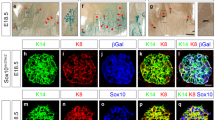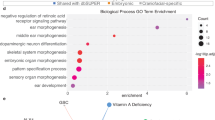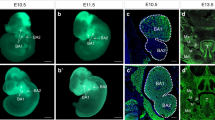Abstract
THE retinoic acid-inducible transcription factor AP-2 is expressed in epithelial and neural crest cell lineages during murine development1–5. AP-2 can regulate neural and epithelial gene transcription, and is associated with overexpression of c-erbB-2 in human breast-cancer cell lines4–6. To ascertain the importance of AP-2 for normal development, we have derived mice containing a homozygous disruption of the AP-2 gene. These AP-2-null mice have multiple congenital defects and die at birth. In particular, the AP-2 knockout mice exhibit anencephaly, craniofacial defects and thoraco-abdominoschisis. Skeletal defects occur in the head and trunk region, where many bones are deformed or absent. Analysis of these mice earlier in embryogenesis indicates a failure of cranial neural-tube closure and defects in cranial ganglia development. We have shown that AP-2 is a fundamental regulator of mammalian craniofacial development.
This is a preview of subscription content, access via your institution
Access options
Subscribe to this journal
Receive 51 print issues and online access
$199.00 per year
only $3.90 per issue
Buy this article
- Purchase on Springer Link
- Instant access to full article PDF
Prices may be subject to local taxes which are calculated during checkout
Similar content being viewed by others
References
Mitchell, P. J., Timmons, P. M., Hébert, J. M., Rigby, P. W. J. & Tijan, R. Genes Dev. 5, 105–119 (1991).
Meier, P., Koedood, M., Philipp, J., Fontana, A. & Mitchell, P. J. Devl Biol. 169, 1–14 (1995).
Lüscher, B., Mitchell, P. J., Williams, T. & Tjian, R. Genes Dev. 3(10), 1507–1517 (1989).
Byrne, C., Tainsky, M. & Fuchs, E. Development 120, 2369–2383 (1994).
Williams, T., Admon, A., Lüscher, B. & Tjian, R. Genes Dev. 2, 1557–1569 (1988).
Bosher, J. M., Williams, T. & Hurst, H. C. Proc. natn. Acad. Sci. U.S.A. 92, 744–747 (1995).
Chen, J. M. J. Anat. 86, 373–386 (1952).
Hall, B. K. J. Embryol. exp. Morph. 93, 133–152 (1986).
Davis, A. P., Witte, D. P., Hsieh-Li, H. M., Potter, S. S. & Capecchi, M. R. Nature 375, 791–795 (1995).
Le Douarin, N. M., Ziller, C. & Couly, G. F. Devl Biol. 159, 24–49 (1993).
Hall, B. K. & Hörstadius, S. The Neural Crest (Oxford Univ. Press, 1988).
Copp, A. J., Brook, F. A., Estibeiro, P., Shum, A. S. W. & Cockcroft, D. L. Prog. Neurol. 35, 363–403 (1990).
Echelard, Y., Vassileva, G. & McMahon, A. P. Development 120, 2213–2224 (1994).
Morriss-Kay, G. & Chen, W.-H. Neural Tube Defects (ed. Bock, G. & Marsh, J.) 51–56 (John Wiley, Chichester, UK, 1994).
Bronner-Fraser, M. FASEB J. 8, 699–706 (1994).
Copp, A. J. Neural Tube Defects (ed. Bock, G. & Marsh, J.) 118–134 (John Wiley, Chichester, UK, 1994).
Chen, Z.-F. & Behringer, R. R. Genes Dev. 9, 686–699 (1995).
Günther, T., Struwe, M., Aguzzi, A. & Schughart, K. Development 120, 3119–3130 (1994).
Stumpo, D. J., Bock, C. B., Tuttle, J. S. & Blackshear, P. J. Proc. natn. Acad. Sci. U.S.A. 92, 944–948 (1995).
Morriss-Kay, G. Bioessays 15, 9–15 (1993).
Kotch, L. E. & Sulik, K. K. Am. J. med. Genet. 44, 168–176 (1992).
Wei, X. & Sulik, K. K. Am. J. med. Genet 47, 862–871 (1993).
Davies, A. F. et al. Hum. molec. Genet. 4, 121–128 (1995).
Warren, G., Gordon, M., Siracusa, L. D., Buchberg, A. M. & Williams, T. Genomics 31, 234–237 (1996).
Williams, T. & Tjian, R. Genes Dev. 5, 670–682 (1991).
Williams, T. & Tjian, R. Science 251, 1067–1071 (1991).
Kuida, K. et al. Science 267, 2000–2003 (1995).
Martin, J. F., Bradley, A. & Olson, E. N. Genes Dev. 9, 1237–1249 (1995).
Matsuo, I., Kuratani, S., Kimura, C., Takeda, N. & Aizawa, S. Genes Dev. 9, 2646–2658 (1995).
Mark, M. et al. Development 119, 319–338 (1993).
Author information
Authors and Affiliations
Rights and permissions
About this article
Cite this article
Zhang, J., Hagopian-Donaldson, S., Serbedzija, G. et al. Neural tube, skeletal and body wall defects in mice lacking transcription factor AP-2. Nature 381, 238–241 (1996). https://doi.org/10.1038/381238a0
Received:
Accepted:
Issue Date:
DOI: https://doi.org/10.1038/381238a0
This article is cited by
-
Shaping faces: genetic and epigenetic control of craniofacial morphogenesis
Nature Reviews Genetics (2023)
-
Epigenetically modified AP-2α by DNA methyltransferase facilitates glioma immune evasion by upregulating PD-L1 expression
Cell Death & Disease (2023)
-
Transcription factors AP-2α and AP-2β regulate distinct segments of the distal nephron in the mammalian kidney
Nature Communications (2022)
-
A coordinated progression of progenitor cell states initiates urinary tract development
Nature Communications (2021)
-
Epigenetic control of melanoma cell invasiveness by the stem cell factor SALL4
Nature Communications (2021)
Comments
By submitting a comment you agree to abide by our Terms and Community Guidelines. If you find something abusive or that does not comply with our terms or guidelines please flag it as inappropriate.



